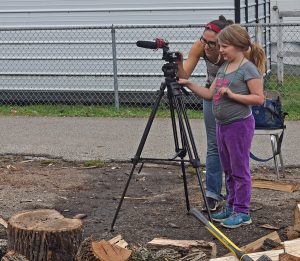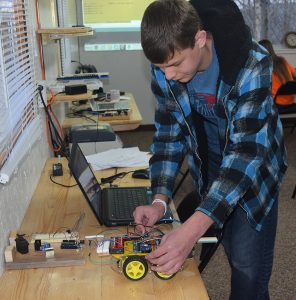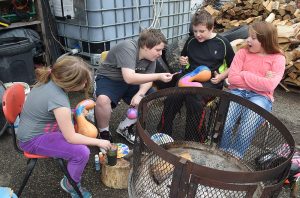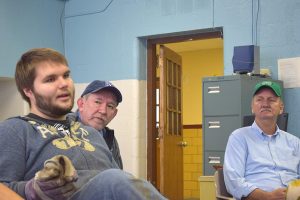Growing Up Appalachian
The next generation is overcoming barriers to achieve their goals
By Molly Moore

Hannah Cox experiments with a video camera with guidance from Rachel Berkot, a RAMPS member. Photo by Willie Dodson
Answers to broad questions about Appalachia’s future — such as how coal-bearing counties will transform as the region’s chief industry declines — are invariably traced back to the next generation. The region’s future will be shaped one child, one teen and one young adult at a time.
The story of what young people in the region are experiencing — what their hopes and dreams are and what obstacles are in their way — are as varied as the teens and young adults themselves. Many Appalachian youth express concern about poverty and unemployment, the effectiveness of the educational system, and the national opioid and prescription drug abuse epidemic that has disrupted families and young lives.
In rural Appalachia, there’s long been a perception that to be successful, young people must leave the mountains. But today, there is a growing movement among local residents to undo that narrative and create opportunities for youth of all backgrounds, identities and aspirations to thrive.
Numerous regional organizations and programs — both youth- and adult-led — are working to support young people. We spoke with individuals from several such organizations to provide a window into their stories.
Clintwood Learning Co-op

Elijah Kiser adjusts the robotic car during the Clintwood Learning Co-op’s robotics and coding program. Photo by Willie Dodson
In a one-room building overlooking the rolling mountains of Dickenson County, Va., three young teens are focused on a small robotic car. The car has four standard wheels, but its body is a flat platform with two exposed circuit boards, a nest of wires, a battery pack and a small PVC pipe mounted at the front.
Using coding and mechanics they’ve built through trial and error and an improvised light detector inside the PVC pipe, the boys send the car toward a lamp on the floor. If all works as intended, the car will detect the light and stop before the vehicle impacts it. According to their teacher, Vincent Fanelli, these teens are experimenting with a version of the same technology that underlies advanced research into self-driving cars.
The free after-school program in robotics is offered by the Clintwood Learning Co-op, a project of Fourth World/USA, which is a branch of a global organization dedicated to eradicating poverty. Vincent and Fanchette Fanelli have run the center for more than twenty years, hosting workshops in traditional skills such as weaving as well as newer fields like computers. The robotics program is their first youth-focused venture.
The teens all have rave reviews. “It gives a new perspective to electronics, and how we can start commanding our own to do what we want,” says workshop participant Elijah Kiser. The students have taken their experiments home to tinker with coding, circuit boards and solar lights. For one 10th-grader, this interest in mechanics led to an engineering class at the vocational school, where he helped set up a 45-foot wind turbine to power the heating and lights in a storage building.
These young teens have clear ideas of what they would like to do in the future — go to college, work with military robots and drones or do computer animation. Asked if they want to stay in Dickenson County, they respond with a chorus of “yes,” citing family, the landscape and the hunting and fishing opportunities.
But for now, as much as the teens enjoy their twice-weekly foray into robotics and coding, the program’s reach is small. Situated just a five-minute drive from the county’s new consolidated high school, it’s nonetheless difficult to attend for students under 16 or without access to a vehicle. Dorothy Kiser, Elijah’s mother, drives 45 minutes to bring the three boys to the co-op; she visits and crafts with several other local women at the co-op’s main building while the program is in session.
Vincent Fanelli hopes to make transportation arrangements with the school to make the robotics program more accessible.
The future for young people in the areas comes down to having viable opportunities, notes Dorothy Kiser, citing the growing solar and wind industries as examples of what could be. She says it would be difficult for her son to pursue a computer programming career locally right now. But that could change.
“We just started our community center and I noticed that a lot of the places in Dickenson County have started to get people more involved in their communities to try to pull in some job opportunities and companies,” she says. “Like with this program, this was a blessing for me.”
Visit fwlearningco-op.org
Western Youth Network

Campers with the Western Youth Network in Boone, N.C., pose with the organization’s new vehicle, nicknamed the Spaceship. Photo courtesy Western Youth Network
In northwestern North Carolina’s High Country, many of the campers at the Western Youth Network summer program had never been to the overlooks along the Blue Ridge Parkway, a 469-mile scenic drive maintained by the National Park Service that runs through these campers’ home counties. When they journeyed to parkway overlooks in July, the campers were overcome by emotion and one told camp staff it was the best day of his life.
The Western Youth Network primarily serves middle-school-aged youth, but also provides mentoring for ages six to 17 and runs a substance abuse prevention effort.
The nonprofit’s Executive Director Jennifer Warren says that one of the greatest challenges is a phenomenon called toxic stress, which can occur when youth experience traumatic events without the support of a stable caregiver — common especially with the “exceptionally high amount of children in foster care” in the region. According to Warren, toxic stress can lead to “poor impulse control, inability to make good social bonds or resolve conflict peacefully.”
“One of the ways we’re really trying to work to repair this is to match kids with a stable, nurturing caregiver, through our after school or summer programming, because that’s the one thing that the research shows actually pulls a kid out and helps them rewire their brain,” she says.
In rural areas, Warren notes, the problems kids face can go unnoticed. Youth without transportation who live farther from towns have limited access to opportunities and social services. To address transportation, Western Youth Network has a fleet of vehicles and is able to take kids home following after-school programs and provide pick-up and drop-off services for summer programs.
But the mountains can also offer advantages. “I also think about how easy it is for people to access land for playing, being physically active, running around, gardens that allow them fresh food at a reasonably low rate,” Warren says.
Perhaps that’s why, when the kids reached the top of one of the parkway overlooks, they shouted: “I love this place!”
Visit westernyouthnetwork.org
RAMPS Youth Engagement Project

Hannah Cox, Nathanael Green, Jeremiah Cox and Emily Cox transform salvaged squash into art in the parking lot of the former RAMPS building. Photo by Willie Dodson
The members of Radical Action for Mountains’ and People’s Survival didn’t set out to run a youth program. But part of the environmental collective’s philosophy of direct action is to directly serve and empower communities. So when kids and teens started showing up at the rundown building in Whitesville, W.Va., that served as their office and home, they went with it.
“The fact that the kids were kind of jammed in here, for many, many hours, a lot — that was telling me that what they needed were activities for young people,” says David Baghdadi of RAMPS.
In the fall, members of the collective, often accompanied by neighbors and friends, took youth out into the nearby woods to gather timber, teaching interested kids how to split firewood. Youth whose families rely on wood heat took firewood back to their families. Participating youth also received a $2 hourly wage, and a portion of the profits from any wood that was sold to others in the community.
The group took youth out to the woods to gather ginseng and offered art activities, the opportunity to experiment with video cameras, and perhaps most importantly, a central gathering spot.
“In my opinion, the kids kind of run a little bit wild here,” Baghdadi says, hypothesizing that it might be because some of the negative examples they see in the community. “If they see the adults and the authorities divesting, not having much interest in the community, they take that in.” He says that overall, the group is trying to be a positive presence and “show to young people that there are people who want to invest in this place, that want to invest in them.”

Isaac Barker, right, watches as Kayla Cox learns to split wood at the former RAMPS office. The two teens are entering high school in 2016. Barker enjoys spending time in the woods, hunting and gathering ginseng, and would like to eventually work for the W.V. Division of Natural Resources, preferably in his home area. He says he is looking forward to animal dissections in science class and continued involvement in the school robotics program. Photo by Molly Moore
In the spring, RAMPS purchased an old boarding house in town and set aside a youth room, replete with books, toys and arts supplies. “That space is really increasing our capacity to do things and increasing our capacity to deepen connections with community here,” says Rachel Berkrot, a member of RAMPS focused on the youth project. Neighbors and youth of all ages hang out on the porch and share meals, and one of the RAMPS members has been teaching kids how to make donuts in kitchen.
The group has also acquired a nearby gardening space. Along with others in the community, they intend to build raised beds and eventually cultivate fruit trees and medicinal herbs — and give the youth an opportunity to get involved. Another large project on the horizon is building a cabin with the youth in the hills above Whitesville. Berkrot notes that the endeavor would give kids another activity as a chance to practice construction skills.
“[Members of RAMPS] are setting a good example for the kids, they really are,” says Tom Bowe, father of Coy, one of the regular youth attendees. “The [kids] are learning to make your way in life.”
Visit rampscampaign.org
Haywood Community Learning Center
In Haywood County in western North Carolina, Kyle Ledford operates an alternative learning program that provides students who have dropped out of high school with a chance to recover credits, earn a GED or return to their home school.
“We certainly don’t have enough housing, enough public transportation,” Ledford says. “Generational poverty of course in [Appalachia] is very, very hard to break. This is a societal problem, it’s going to take a societal solution.”
The current Haywood Community Learning Center serves between 175 to 200 students at any given time, and graduates between 35 and 50 per year.
Each student has a customized plan that includes providing transportation and food assistance to students who need it. More than a dozen local faith organizations also serve hot lunches and breakfasts at the center year-round. And the academic component is flexible and allows students to take as much or little time as they need to master a subject.
The dropout rate at Haywood County Public Schools has fallen from 8 percent in 2007 to 0.93 percent in 2014. Despite this success, Ledford isn’t satisfied with the post-diploma options for young people.
“The kids that we have in the building, the majority are interested in the trade aspect,” he says. “The the greatest barrier to them is generational — [the feeling that] they can’t be the first person to do that. And the lack of opportunity in this area to get that type of training.”
Ledford observes that many students who go on to community college for vocational training get stymied by prerequisite and remedial classes. “If school didn’t work for you for whatever reason, more of the same isn’t going to work for you again,” he says. “I think the economic vitality of the region is more important than adhering to a bunch of rules.”
“You have to work outside the box, kids aren’t one-size-fits-all,” he says.
Visit clc.haywood.k12.nc.us
Rural Appalachian Improvement League

Shane Bishop of Wyoming County, W.Va., discusses ways to improve the community with other team members at the Mullens Opportunity Center. Photo by Willie Dodson.
Many residents of the Wyoming County, W.Va., town of Mullens are familiar with both hardship and rebuilding, whether it’s economic struggle related to the coal industry’s latest bust or devastation from the landmark 2001 flood that inundated the town.
The Mullens Opportunity Center, formerly a public school, is a testament to community service. Local volunteers help maintain the center’s gardens, college spring breakers built the high tunnel to extend the growing season, and a visiting team of AmeriCorps service members constructed the center’s outdoor community stage.
On an unseasonably warm morning in December 2015, roughly a dozen local residents gathered at the center to share their thoughts on reinvigorating the area. The people in the room were serving with the nonprofit Rural Appalachian Improvement League through a variety of agencies, including a workforce development program called ROSS IES, the national service program AmeriCorps, and the Experience Works program for seniors.
There was no shortage of ideas — establishing a shop to repair all terrain vehicles, fixing up old buildings, cleaning up the local river for fishing tournaments and building hiking trails, to name a few.
Though the ROSS IES and AmeriCorps members were young themselves — generally in their late teens and early 20s — many expressed concern about the generation younger than them.
Shane Bishop, a local resident participating in the program through ROSS IES, said it might be up to his generation to help kids growing up now become involved in the community instead of falling into a habit of disengagement.
“They don’t see where their actions are taking them,” he said, noting the state’s high rates of obesity and prescription drug abuse. “It’s just time for people to open up their eyes.”
The group discussed the combined factors that some young people in the area face: troubled home lives, addiction to social media and video games, and the drug abuse epidemic. Soon, the topic changed to what the RAIL team could do about it — ideas such as hosting movie screenings of popular films to bring youth to the center.
“If we can get the ball rolling on half of this stuff and get more youth members, I say we could probably get it done,” Alexandra Church, as ROSS IES member, said of the group’s ambitions. “It’s just that [younger people] need an example, they need someone to start it.”
Many of the team’s plans were centered around summer. But because of the state’s spring budget delay, the ROSS IES workforce program’s funding didn’t come through in time and the six youth funded by the program lost their positions.
This summer, RAIL has four AmeriCorps members. With the help of local volunteers, the team is focused on gardening, hosting a farmers market and preparing a community play based on local history.
Ruby Ingram serves with the AmeriCorps Farm-to-School program teaching gardening and helping build raised beds at area schools. According to Charlene Cook at the Mullens Opportunity Center, one of the kids was so inspired by his experience with raised beds at school last year that he decided to start gardening at home. Local volunteers and some of the RAIL youth plowed him a garden space, and now he sells his own produce at the center’s farmers market.
Visit railwv.org
The STAY Project
“STAY is about building youth power across the region to improve the experience of youth who live here,” says Izzy Broomfield, a steering committee member of The STAY Project. Short for Stay Together Appalachian Youth, the group aims to support central Appalachian young people — generally ages 14 to 30.
Broomfield, a Berea, Ky., native who also currently serves as an AmeriCorps VISTA in Hazard, Ky., would like to see more intergenerational collaboration and more opportunity for youth to be involved in decision-making that affects them. At times Broomfield has felt like the “token millennial” at the table — given a seat, but not always listened to or respected.
Kendall Bilbrey, coordinator of STAY, notes two recent examples of young people in eastern Kentucky speaking out — and sometimes being heard — about civic issues.
In May, the Letcher County Fiscal Court proposed an ordinance stating that the county would not comply with any regulations that opened public restrooms to transgendered people. A group that identified themselves as “young leaders, most of us in high school, who have lived and grown up in this county” wrote the magistrate a public letter opposing the proposal. The ordinance failed in a vote of 5 to 1. Bilbrey notes that while the dissenting magistrates cited fear of legal trouble, there was “a lot of pressure created from the ground up, which I think tipped the scale.”
The Letcher Governance Project, of which Bilbrey is also a member, is another example of recent youth activism. The group, comprised of local residents who are opposed to a new federal prison proposed for the county, protested at a regional economic development conference in June. “[Local and regional authorities] keep saying that young people aren’t coming to participate in their economy or in their community, but when they do and it’s something [the authorities] disagree with, we’re shut out,” says Bilbrey.
The anti-prison organization has been bringing attention to the proposed jail’s $444 million price tag by asking people on social media to share alternative ideas about how that money could be spent in eastern Kentucky. According to Bilbrey, many respondents suggested state-of-the art mental health and drug rehabilitation services.
“Why don’t we take problems that are often criminalized in our community turn them into opportunities for healing and support?” they ask. “The more we can shift that the better it will be for young people, for all ages.”
Looking forward, Broomfield says it’s important that central Appalachian residents “be intentional about creating opportunities for young people.” Broomfield notes that while there’s widespread need for employment, younger adults without families or other commitments are more likely to leave if they can’t find viable work.
STAY member Brandon Jent grew up in Whitesburg, Ky., and earned a college degree at the University of Kentucky in Lexington. Upon returning to his hometown, he interned with the Appalachian Media Institute and became involved with the youth organization. Jent says his experiences with the Appalachian Media Institute and STAY have helped him see central Appalachia as “a place where people can live their dream.”
“There’s always been this pressure to leave and not really an option to stay,” he says. “Both are on the table; home is where you want it.”
Visit thestayproject.com
Related Articles
Latest News

Leave a comment
Your email address will not be published. Required fields are marked *





Leave a Comment